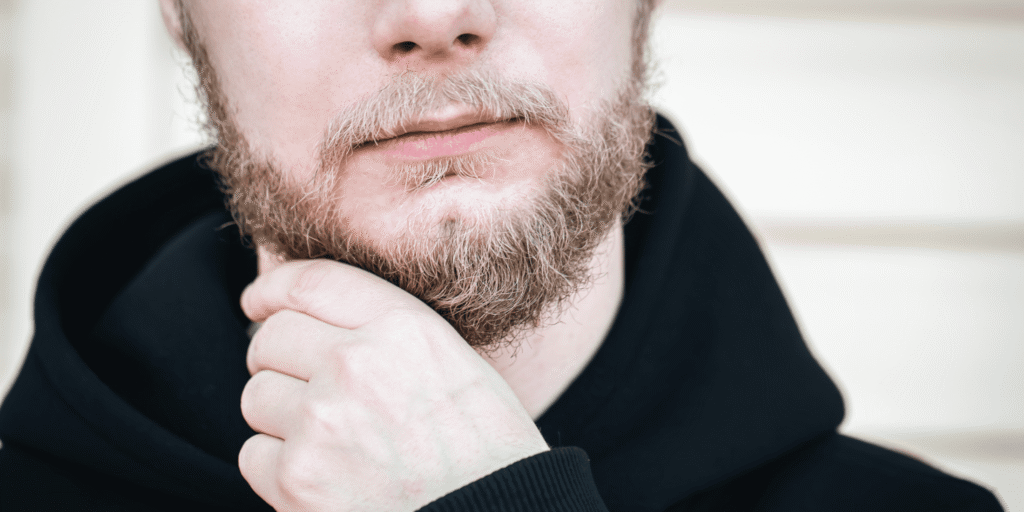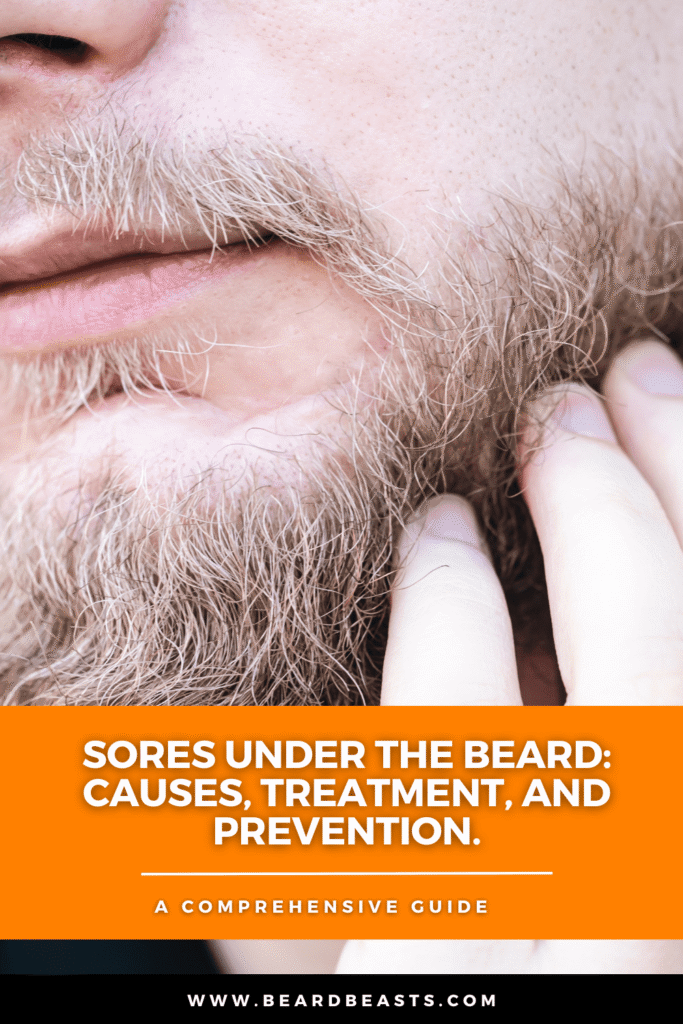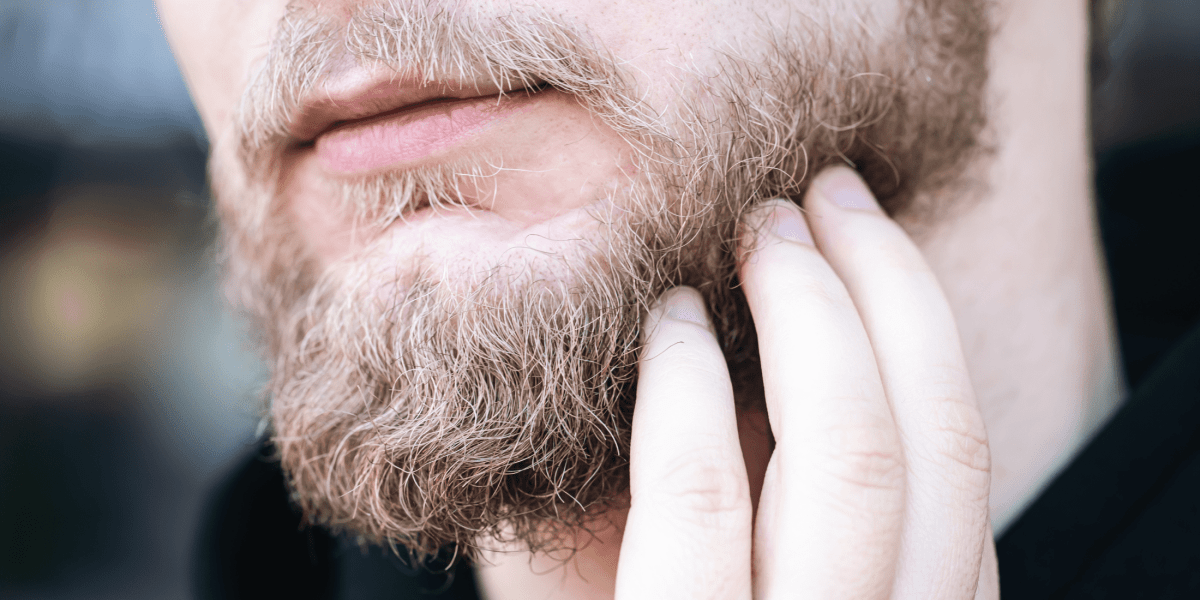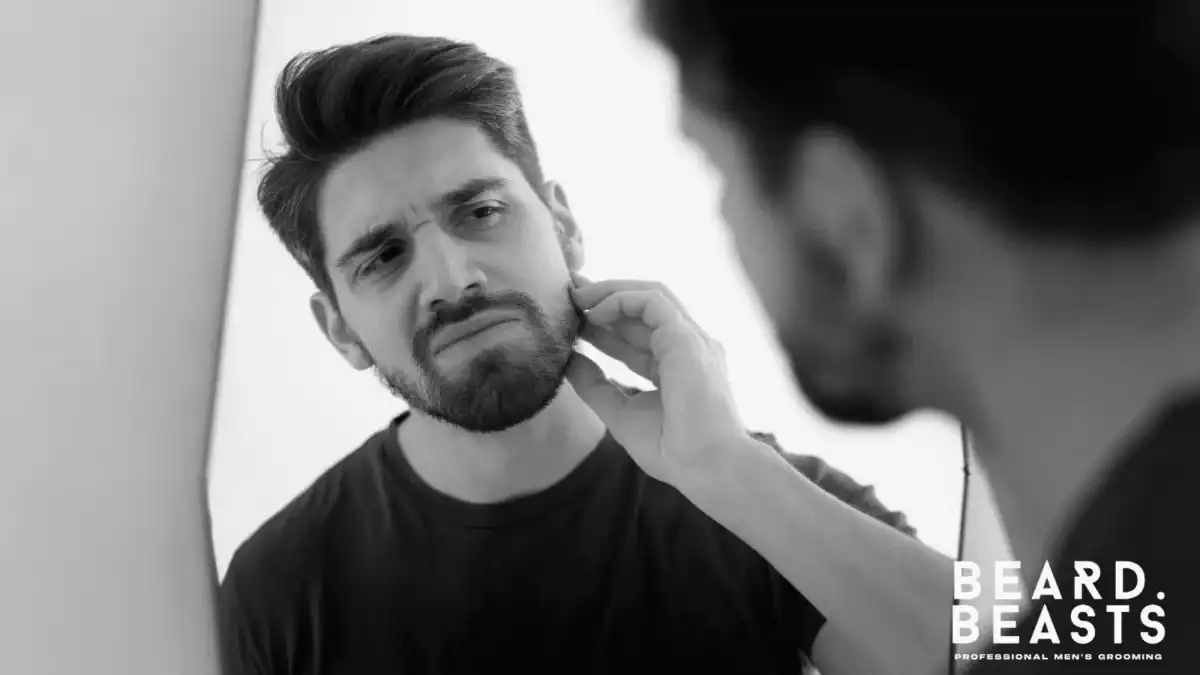Dealing with sores under your beard can be both uncomfortable and frustrating. Beard sores can arise from various causes, including poor hygiene, ingrown hairs, and infections, leaving your facial hair looking less than its best.
This article explores common causes, effective treatments, and prevention tips for beard sores, ensuring your facial hair stays healthy, comfortable, and stylish.
Whether you’re new to beard grooming or a seasoned beard enthusiast, these insights will ensure your beard care routine keeps your facial hair looking great and feeling even better.
Understanding Sores Under Beard
Sores under the beard are irritated, sometimes painful spots that can appear beneath your facial hair, making beard maintenance challenging. These can be caused by a variety of factors and can affect anyone sporting a beard, from the newbie to the seasoned beard enthusiast.

Common Symptoms
If you’re experiencing sores under your beard, you might notice a few common symptoms. Recognizing these early can help you take action and get relief sooner.
Redness
- Red patches are a frequent sign of beard sores.
- This redness can vary from light pink to a more intense red.
- It’s often accompanied by a warm sensation around the affected area.
Itching
- One of the most annoying symptoms is itching.
- This can range from a mild, occasional itch to a relentless, persistent scratchiness.
- Itching can lead to further irritation and even more sores if scratched too much.
Painful Bumps
- Painful bumps can develop under your beard.
- These bumps might feel tender to the touch and can sometimes become quite sore.
- They are often filled with pus, indicating a possible infection.
Why It Matters
Understanding these symptoms is crucial for maintaining your beard health. Ignoring them can lead to more significant issues, including infections that might require medical attention. Keeping an eye out for these signs ensures you can manage beard sores effectively and keep your beard looking and feeling great.
By staying informed about the causes and symptoms of sores under your beard, you can take the necessary steps to treat and prevent them, ensuring your beard remains a source of pride rather than discomfort.
Common Causes of Sores Under Beard
Identifying the common causes of beard sores is crucial for maintaining a healthy and comfortable beard. Let’s dive into some of the main culprits and how they can lead to those pesky beard sores.

Poor Hygiene
Beard hygiene is crucial for maintaining a healthy beard. Neglecting to clean your beard regularly can lead to several issues, including sores.
Impact of Not Cleaning Beard Regularly
- Dirt and Oil Build-Up: Not washing your beard can cause dirt, oil, and dead skin cells to accumulate, creating a breeding ground for bacteria.
- Clogged Pores: The build-up can clog pores, leading to acne and painful sores.
- Bad Odor: A dirty beard can develop an unpleasant smell, making it less appealing to yourself and others.
Tip: Make it a habit to wash your beard with a gentle cleanser a few times a week to keep it clean and fresh.
Ingrown Hairs
Ingrown beard hairs are another common cause of sores under the beard. They occur when hair grows back into the skin instead of rising up from it.
How Ingrown Hairs Cause Sores
- Inflammation: The body reacts to the ingrown hair, causing inflammation and pain.
- Infection: If bacteria get into the inflamed area, it can lead to infection and more severe sores.
Prevention Tips
- Exfoliate Regularly: Use a gentle face scrub to exfoliate your skin and prevent hairs from growing back into it.
- Proper Shaving Techniques: Shave in the direction of hair growth and avoid pulling the skin too tight.
Fungal Infections
Fungal infections are another cause of beard sores. These infections can be itchy, uncomfortable, and persistent.
Types of Fungal Infections Affecting Beards
- Ringworm: A common fungal infection that creates a ring-shaped rash.
- Tinea Barbae: A fungal infection specifically affecting the beard area.
Symptoms and Diagnosis
- Red, Itchy Patches: Look for red, scaly, and itchy patches under your beard.
- Bumps and Pustules: These can form on the infected area.
If you suspect a fungal infection, it’s best to consult a healthcare professional for proper diagnosis and treatment.
Bacterial Infections
Bacterial infections can also lead to sores under the beard. These are typically caused by common bacteria like Staphylococcus aureus.
Common Bacteria Causing Infections
- Staphylococcus Aureus: Often found on the skin, this bacteria can cause painful, pus-filled sores if it enters cuts or abrasions.
How Bacterial Infections Develop
- Cuts and Nicks: Shaving or trimming can create small cuts, providing an entry point for bacteria.
- Poor Hygiene: Not cleaning your beard regularly can allow bacteria to thrive.
Tip: Keep your beard and the skin underneath clean to prevent bacterial infections. If you notice painful, pus-filled sores, seek medical advice.
Skin Conditions
Certain skin conditions can also cause beard sores. These conditions can be chronic and require ongoing management.
Psoriasis
- Red, Scaly Patches: Psoriasis can cause red, scaly patches under your beard that may be itchy or sore.
Eczema
- Itchy and Inflamed Skin: Eczema causes itchy, inflamed skin, which can lead to sores if scratched excessively.
Dermatitis
- Redness and Swelling: Dermatitis can cause redness, swelling, and sometimes blisters under the beard.
If you have any of these skin conditions, it’s important to follow your healthcare provider’s advice and use appropriate treatments to manage symptoms.
By understanding these common causes, you can take proactive steps to prevent and treat sores under your beard, ensuring your beard remains healthy and looking its best.
Effective Treatment Options
Knowing the best treatment options is essential when dealing with beard sores. Here, we’ll explore various effective treatments, from over-the-counter solutions to natural remedies, to help you get your beard back to its best condition.
Over-the-Counter Solutions
OTC beard treatments are often the first line of defense against beard sores. These solutions are easily accessible and can provide quick relief.
Topical Creams and Ointments
- Hydrocortisone Cream: Reduces inflammation and itching.
- Antibacterial Ointments: Helps to prevent or treat bacterial infections.
- Anti-fungal Creams: Effective for treating fungal infections like ringworm.
Tip: Always follow the instructions on the packaging and consult with a pharmacist if you’re unsure which product is best for you.
Prescription Medications
Sometimes, sores under beard may require stronger treatment that only a doctor can prescribe.
When to See a Doctor
- Persistent Symptoms: If your symptoms don’t improve with OTC treatments.
- Severe Pain or Swelling: Indications of a more serious infection.
- Spreading Sores: If sores are spreading beyond the beard area.
Common Prescriptions
- Antibiotics: For bacterial infections.
- Stronger Anti-fungal Medications: For persistent fungal infections.
- Steroid Creams: For severe inflammation and itchiness.
Tip: Don’t hesitate to seek professional help if your condition worsens or doesn’t improve with home treatments.
Natural Remedies
For those who prefer a more natural approach, several remedies can help soothe and treat sores under the beard.
Aloe Vera
- Anti-inflammatory: Reduces redness and swelling.
- Moisturizing: Keeps the skin hydrated and promotes healing.
Tea Tree Oil
- Antibacterial and Anti-fungal: Helps combat infections.
- Soothing: Reduces itching and irritation.
Tip: Dilute tea tree oil with a carrier oil (like coconut oil) before applying it to the skin to prevent irritation.
Honey
- Antibacterial: Helps prevent and treat infections.
- Healing Properties: Promotes faster healing of sores.
Proper Beard Care Routine
Maintaining a proper beard care routine is essential for preventing and managing sores under the beard.
Cleaning and Conditioning
- Regular Washing: Use a gentle beard wash to keep your beard clean.
- Conditioning: Apply a beard conditioner to keep the hair soft and manageable.
Beard Oils and Balms
- Beard Oils: Moisturize the skin and hair, reducing dryness and irritation.
- Beard Balms: Provide a protective barrier and help in styling your beard.
Tip: Look for products with natural ingredients to minimize the risk of irritation.
By exploring these effective treatment options, you can find the right solution to manage and treat your beard sores. Whether you opt for over-the-counter treatments, natural remedies, or prescription medications, taking proactive steps will help you maintain a healthy and comfortable beard.
Preventing Sores Under Beard
Preventing beard sores involves maintaining a good routine and making informed choices. Here are some practical tips to keep your beard healthy and free from sores.
Maintaining Good Hygiene
Good hygiene is the foundation of a healthy beard. Keeping your beard clean can prevent many common issues, including beard sores.
Regular Washing and Grooming
- Daily Cleansing: Wash your beard with a gentle beard shampoo to remove dirt, oil, and bacteria.
- Brushing and Combing: Regularly brush your beard with a boar bristle beard brush to prevent tangles and distribute natural oils.
Tip: Make sure to rinse thoroughly to remove all shampoo residues, which can irritate the skin.
Proper Shaving Techniques
How you shave can have a significant impact on your skin and beard health. Proper techniques can help avoid irritation and ingrown hairs, both common causes of sores under the beard.
Avoiding Irritation and Ingrown Hairs
- Shave in the Direction of Hair Growth: This reduces the risk of hair getting trapped under the skin.
- Use a Sharp Razor: A dull blade can cause nicks and cuts, increasing the risk of infection.
- Don’t Shave Too Close: Leaving a little stubble can help prevent ingrown hairs.
Tip: Always use a good quality shaving cream or gel to reduce friction and protect your skin.
Choosing the Right Products
Using the right products can make a huge difference in preventing beard sores. Look for items that are gentle and suited for your skin type.
Non-Irritating Shampoos and Conditioners
- Mild Formulas: Choose shampoos and conditioners specifically designed for beards, which are often milder than regular hair products.
- Natural Ingredients: Products with natural ingredients are less likely to irritate your skin.
Quality Beard Oils and Balms
- Hydrating Oils: Beard oil will moisturize the skin and hair, preventing dryness and irritation.
- Protective Balms: Beard balm can help lock in moisture and provide a barrier against environmental irritants.
Tip: Test new products on a small skin area to check for allergic reactions before applying them to your entire beard.
Healthy Lifestyle Choices
Your lifestyle choices also play a crucial role in maintaining a healthy beard. Diet, hydration, and stress management can all affect your skin and hair health.
Diet and Hydration
- Balanced Diet: Eat a diet rich in vitamins and minerals, such as fruits, vegetables, and lean proteins, to support healthy hair growth.
- Stay Hydrated: Drink plenty of water to keep your skin hydrated from the inside out.
Stress Management
- Reduce Stress: High stress levels can affect your skin’s health, leading to issues like dryness and irritation.
- Relaxation Techniques: Practices such as yoga, meditation, and regular exercise can help manage stress effectively.
Tip: Incorporate foods high in omega-3 fatty acids, like fish and nuts, which are great for skin health.
By following these preventive measures, you can significantly reduce the risk of developing sores under your beard and enjoy a healthy, well-maintained beard. Remember, consistency is key, so make these tips a regular part of your beard care routine.
When to Seek Professional Help
While many issues with beard sores can be managed at home, sometimes professional help is necessary. Here’s how to know when it’s time to see a doctor and what to expect during your visit.
Identifying Severe Symptoms
Certain symptoms indicate that you should seek professional medical advice. Ignoring these signs can lead to more serious complications.
Persistent Pain
- Constant Discomfort: If you experience ongoing pain that doesn’t improve with over-the-counter treatments, it’s time to consult a professional.
- Sharp or Severe Pain: Any sharp or severe pain should be evaluated by a healthcare provider.
Spreading Infections
- Increasing Redness and Swelling: If the redness and swelling are spreading beyond the initial area, it could indicate a more serious infection.
- Pus and Fever: The presence of pus or fever along with beard sores suggests a bacterial infection that needs medical attention.
Consulting a Dermatologist
A dermatologist specializes in skin conditions and can provide expert care for sores under the beard. Here’s what you can expect during your visit.
What to Expect During the Visit
- Medical History: The dermatologist will ask about your medical history, any allergies, and the symptoms you’re experiencing.
- Physical Examination: They will closely examine the affected area to determine the cause of your beard sores.
Possible Tests and Treatments
- Skin Swabs or Biopsies: In some cases, a sample from the sore may be taken to identify the exact cause of the infection.
- Prescription Medications: Depending on the diagnosis, the dermatologist may prescribe stronger medications like antibiotics, antifungal treatments, or corticosteroids.
- Follow-Up Appointments: You might need follow-up visits to ensure that the treatment is working and to monitor your progress.
Why Seeking Help is Important
Addressing severe symptoms early can prevent more serious complications and ensure you receive the most effective treatment. Remember, it’s always better to be safe and get a professional opinion if you’re unsure about your condition.
By understanding when to seek professional help and what to expect from a dermatologist visit, you can take proactive steps to effectively manage and treat sores under your beard. This ensures your beard remains healthy, comfortable, and looking its best.
Frequently Asked Questions (FAQs)
Having beard sores can be frustrating and worrisome. To help you better understand and manage this issue, here are some frequently asked questions along with friendly and straightforward answers.
What Causes Sores Under the Beard?
Sores under the beard can result from a variety of factors:
- Poor Hygiene: Not cleaning your beard regularly can lead to bacteria buildup.
- Ingrown Hairs: These occur when hairs grow back into the skin, causing inflammation.
- Fungal Infections: Fungi like ringworm can infect the beard area.
- Bacterial Infections: Bacteria entering cuts or abrasions can cause infections.
- Skin Conditions: Conditions like psoriasis, eczema, and dermatitis can lead to sores.
How Do I Get Rid of Sores on My Beard?
To treat sores on your beard, follow these steps:
- Keep It Clean: Wash your beard regularly with a mild beard shampoo.
- Use Topical Treatments: Apply over-the-counter creams or ointments as needed.
- Avoid Scratching: Scratching can worsen sores and spread infection.
- Consult a Doctor: If sores persist, seek medical advice for stronger treatments.
How Can I Tell if My Beard Sore is Infected?
Look out for these signs to determine if a beard sore is infected:
- Increased Redness and Swelling: If the area around the sore becomes more red and swollen.
- Pus Formation: Presence of yellow or green pus indicates an infection.
- Pain and Warmth: Infected sores are often painful and may feel warm to the touch.
- Fever: A fever may accompany an infection, suggesting the need for medical intervention.
Tip: If you notice any of these signs, consult a healthcare professional promptly.
Can Beard Products Cause Sores?
Yes, certain beard products can contribute to sores under the beard:
- Allergic Reactions: Some ingredients in beard oils, balms, or shampoos can cause allergic reactions.
- Irritants: Harsh chemicals in some products can irritate the skin.
- Pore Clogging: Heavy oils or balms can clog pores, leading to acne and sores.
Tip: Always choose products with natural, gentle ingredients and perform a patch test before applying new products to your entire beard.
Valuable Insights
Understanding the causes and treatments is crucial for maintaining a healthy beard. By following proper hygiene, using the right products, and knowing when to seek professional help, you can keep your beard looking and feeling its best.
Don’t let beard sores get in the way of enjoying your awesome facial hair!
Remember, if you ever have doubts or persistent issues, it’s always a good idea to consult with a dermatologist for personalized advice and treatment.

Conclusion
While dealing with beard sores can be frustrating, the right knowledge and care can keep your beard healthy and comfortable. Let’s recap some of the key points we’ve covered to ensure you have all the information you need.
Key Takeaways
- Understanding Causes: Poor hygiene, ingrown hairs, fungal and bacterial infections, and skin conditions like psoriasis, eczema, and dermatitis can all lead to beard sores.
- Effective Treatments: From over-the-counter solutions to prescription medications and natural remedies, there are plenty of ways to treat sores under the beard. Keeping your beard clean and using the right products are crucial.
- Prevention Tips: Maintain a regular beard washing routine, use proper shaving techniques, choose non-irritating products, and adopt a healthy lifestyle to prevent beard sores.
- When to Seek Help: Persistent pain, spreading infections, and severe symptoms are signs that you should consult a healthcare professional.
Helpful Reminders
- Consistency is Key: Regular grooming and hygiene are essential for preventing and managing beard sores.
- Choose Quality Products: Opt for natural, gentle beard care products to minimize the risk of irritation and allergic reactions.
- Stay Informed: Understanding the causes and symptoms of beard sores helps you take prompt and effective action.
Final Thoughts
Your beard is more than just facial hair—it’s a statement of style and personality. Taking good care of it not only enhances your appearance but also ensures your skin remains healthy and comfortable. By following the tips and advice in this article, you can effectively manage and prevent sores under your beard, keeping your beard looking its best.
If you ever have any doubts or persistent issues, don’t hesitate to seek professional advice. A healthy beard is a happy beard, and with the right care, you can enjoy your facial hair to the fullest. Keep grooming, stay informed, and rock that beard with confidence!





